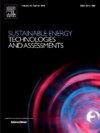Strategies to reduce carbon and water footprints in lignocellulosic biorefineries towards net zero carbon emissions
IF 7
2区 工程技术
Q1 ENERGY & FUELS
Sustainable Energy Technologies and Assessments
Pub Date : 2025-07-22
DOI:10.1016/j.seta.2025.104454
引用次数: 0
Abstract
The successful deployment of lignocellulose biorefinery (LBR) has potential to address the global challenges including, environmental degradation, energy security, climate change and poverty eradication. Biorefineries of lignocellulosic biomass (LCB) provide a wide array of bioproducts through different means including biochemical, thermochemical and catalytic routes boosting circular economy. LCB, by virtue, is consisted of complex polysaccharides and lignin which contribute to high recalcitrance eventually requiring high energy, water, chemicals for its processing into biofuels, biochemicals and biomaterials. Because of diverse and complex processing routes, significant amounts of carbon and water footprints (CWFs) exerts in the biorefinery. Reducing CWFs in LBR is essential for the sustainable industrial practices. This review explores strategies to reduce the CWFs, which are the key to advancing biofuel and chemical production from LCB. This review presents a novel integrated analysis of strategies that simultaneously target CWFs, providing comprehensive framework that aligns with global decarbonization and sustainable resource management by investigating various unit operations in LBRs, starting with biomass pretreatment, enzymatic hydrolysis and proceeding to fermentation or catalytic conversion to product followed by downstream processing. Selection of eco-friendly and efficient processing routes, and considering the effective utilization of LCB including induction of 3Rs (reuse, reduce and recycle) can remarkably overcome the CWFs in LBRs. The article thoroughly examines the factors contributing to the CWFs and identifies key strategies for minimizing impacts on environment and natural resources, thus supporting the transition towards more environmentally-friendly and sustainable LBRs.

减少木质纤维素生物精炼厂碳足迹和水足迹的战略,以实现净零碳排放
木质纤维素生物炼制(LBR)的成功应用有望解决包括环境退化、能源安全、气候变化和消除贫困在内的全球挑战。木质纤维素生物质(LCB)的生物精炼厂通过不同的途径,包括生化、热化学和催化途径,提供广泛的生物产品,促进循环经济。由于LCB由复杂的多糖和木质素组成,这有助于高顽固性,最终需要高能量,水和化学品将其加工成生物燃料,生物化学品和生物材料。由于生物炼制过程的多样性和复杂性,产生了大量的碳足迹和水足迹(CWFs)。减少LBR中的cwf对可持续的工业实践至关重要。这篇综述探讨了减少CWFs的策略,这是推进LCB生物燃料和化学品生产的关键。这篇综述提出了一种新颖的综合分析策略,同时针对CWFs,通过研究lbr中的各种单元操作,从生物质预处理,酶解到发酵或催化转化到产品,然后是下游加工,提供了与全球脱碳和可持续资源管理相一致的综合框架。选择环保高效的处理路线,并考虑LCB的有效利用,包括诱导3r (reuse, reduce和recycle),可以显著克服lbr中的CWFs。本文详细分析了造成CWFs的因素,并确定了减少对环境和自然资源影响的主要策略,从而支持向更环保和可持续的LBRs过渡。
本文章由计算机程序翻译,如有差异,请以英文原文为准。
求助全文
约1分钟内获得全文
求助全文
来源期刊

Sustainable Energy Technologies and Assessments
Energy-Renewable Energy, Sustainability and the Environment
CiteScore
12.70
自引率
12.50%
发文量
1091
期刊介绍:
Encouraging a transition to a sustainable energy future is imperative for our world. Technologies that enable this shift in various sectors like transportation, heating, and power systems are of utmost importance. Sustainable Energy Technologies and Assessments welcomes papers focusing on a range of aspects and levels of technological advancements in energy generation and utilization. The aim is to reduce the negative environmental impact associated with energy production and consumption, spanning from laboratory experiments to real-world applications in the commercial sector.
 求助内容:
求助内容: 应助结果提醒方式:
应助结果提醒方式:


